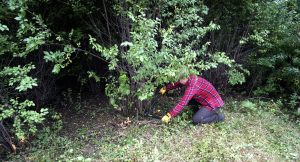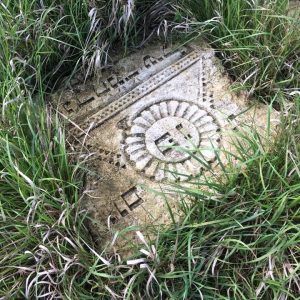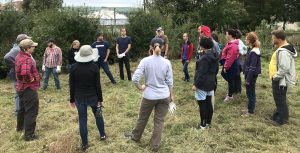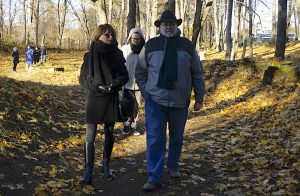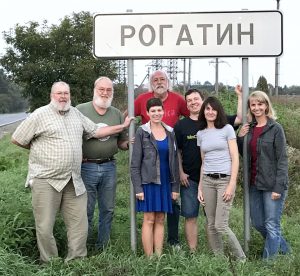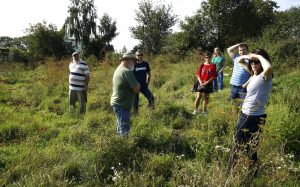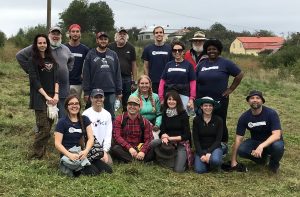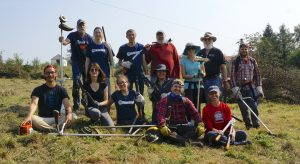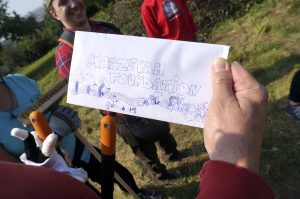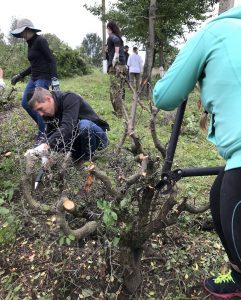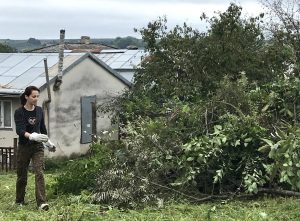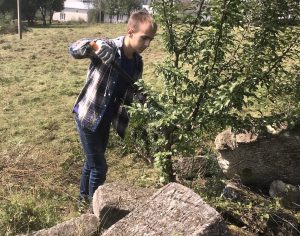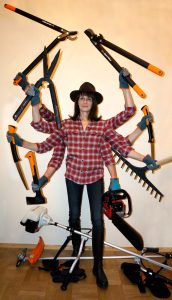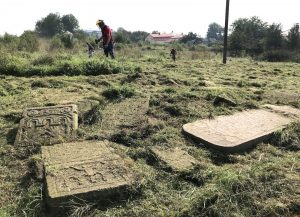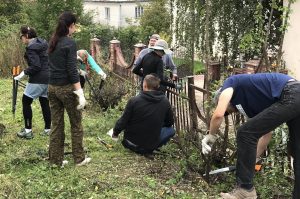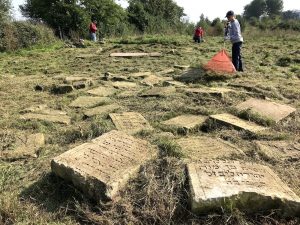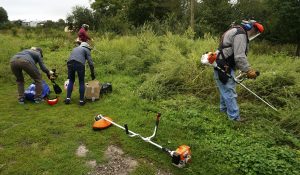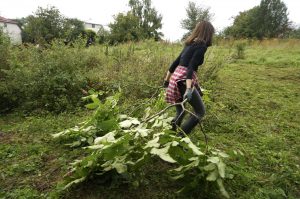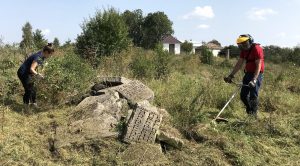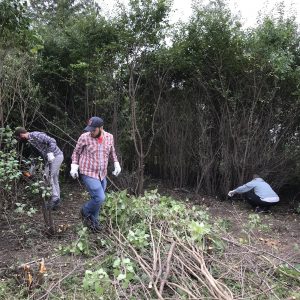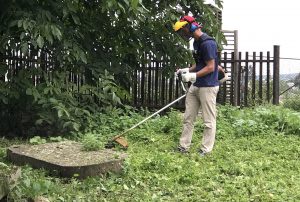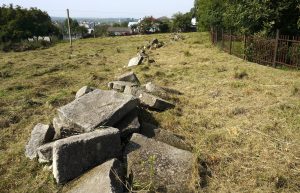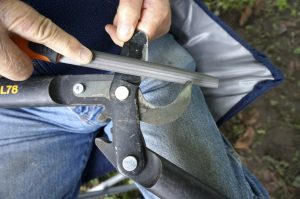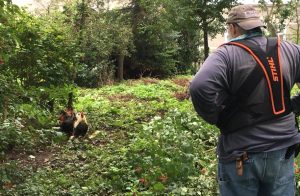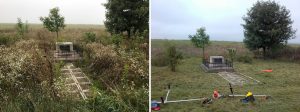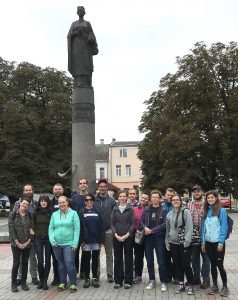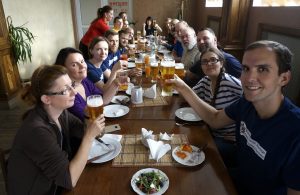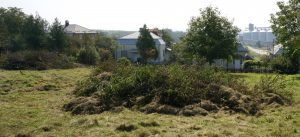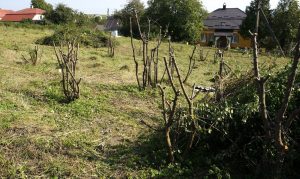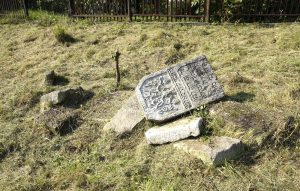Over five days last week, Marla and I worked alongside many of our old and new friends in an organized clearing of wild vegetation at Rohatyn’s old Jewish cemetery. Using new tools paid for by generous donors as well as a lot of sweat and energy, we managed to clear roughly 80% of the large site of grasses, weeds, shrubs, vines, thorn brush, and small trees, revealing the hundreds of headstone fragments gathered there by Rohatyn Jewish Heritage over the last seven years, and establishing a basis for future rehabilitation work. We also learned a lot about the tools and the process, to help us conduct similar projects in Rohatyn in the future and support other volunteer organizations in the region. This article is an overview of the project just completed, and the wonderful people who helped.
![]() Ця стаття також доступна українською.
Ця стаття також доступна українською.
The Challenge
The historic Jewish cemetery just southeast of Rohatyn’s city center dates from the 17th century, and was in continuous use for 300 years; it was closed for over-crowding in the interwar period of the 20th century, when the new Jewish cemetery north of town was opened. As seen in images from WWI and in the 1930s, the cemetery was filled with closely-spaced tall matzevot. During the German occupation in WWII, nearly every gravestone in the old cemetery was broken and stolen for use as building material in the foundations of roads and buildings, a common Nazi practice in eastern Galicia. Since the war, with no surviving Jewish community, the cemetery has seen few visitors, and little attention.
The old cemetery is a sloping rectangle about one hectare (2.5 acres) in area, situated on a hill overlooking the city. Twenty years ago, Jewish survivors and descendants worked with the City of Rohatyn to fence the cemetery, build a retaining wall along two sides, and erect memorials to Rohatyn’s lost Jewish community. For the past seven years, our project to recover broken headstones from Rohatyn streets has gathered the fragments at the lower end of the old cemetery, where they await cemetery rehabilitation and the installation of a new memorial using the recovered stones.
Although every few years the city of Rohatyn does some cutting at the Jewish cemeteries and burns off the growth in areas, it has been at least a decade since this site has had an extensive and intensive clearing. We did not do any clearing work at the old cemetery last year ahead of the non-invasive archaeology survey; only the mass grave sites and the new cemetery were cleared to permit the radar equipment to traverse the ground surface. For the past several years, nature has been triumphant and the old cemetery had become covered with tough wild grasses, and with thickets of thorny shrubs, vines, a variety of saplings, and other plants pushing up through the grass. By this year the grass had become so tall that the most of the recovered headstone fragments and the few standing matzevot were completely obscured. A few larger trees are grouped near a lower corner of the site, providing a bit of shade, but otherwise the cemetery is mostly open to the sky.
In addition to the thorny brush, other threats included stinging nettle and ticks, and earlier this year we had seen a small number of large poisonous plants which burn the skin (heracleum). Given the cemetery’s size, the complexity of the wild vegetation, and the unwelcome irritants, the challenge of clearing the site had been intimidating as we contemplated and planned over the past year.
The Volunteer Working Crew
What made this project successful was of course the people, from planning to logistics to labor and management at the site. In addition to those who worked in advance to arrange tools, lodging, and resources, more than twenty bright people gave their time and energy in hard and dirty work at the cemetery during the week to make a practical impact and a visible statement at this important site of Jewish heritage. What was truly marvelous to see as we worked together was the self-directing and problem-solving approach everyone exhibited, figuring out what was needed and then doing it. It is with humility and love that we acknowledge those who came as leaders and colleagues:
– The Matzevah Foundation
This project got its start on a bus traveling between Jewish heritage sites in Vilnius during a cemeteries conference there in late 2015, when Steven D. Reece, CEO of The Matzevah Foundation (TMF) made a suggestion to us for a joint effort in Rohatyn. TMF had already led projects at several cemeteries in Poland every summer for more than a decade, progressively adding more projects and attracting more volunteers every year. We first met TMF volunteers in 2014 when they were working at the Jewish cemetery of Oświęcim (adjacent to the Auschwitz concentration camp memorial and museum), and we became very good friends soon after; we deeply admire their purpose and their dedication, and have been fortunate to work with them and other volunteers at some of their other project sites in Poland in the past few years.
Although we weren’t prepared to act on Steven’s suggestion in 2015 (while we were still living in Poland), after we moved to Ukraine in late 2016 we began to sketch out a possible joint project, both figuratively and literally. A TMF exploratory visit to Rohatyn last year set the project into planning, logistics, and fundraising. Some of the key details changed during the following months to work around tool transport and border concerns (this was TMF’s first project in Ukraine), but the overall goals remained the same: to clear a large portion of the Rohatyn cemetery, to build a basic tool set for use by volunteers in western Ukraine, and to learn from TMF how to conduct similar projects in the region with other volunteer organizations in the coming years. In the months leading to the work week, TMF gave us generous advice on tools and logistics, and through all the planning they were flexible and kind.
It was our great pleasure to welcome our good friends Steven Reece, Bruce Mussey, Przemek Panasiuk, Rachel McRae, and Rachael Romero to Rohatyn and to Ukraine. It was a blast to be immersed in their gentle manners, good humor, and (mostly) Southern accents once again. Their dedication is inspired and inspiring, patient and steady. Rachel and Rachael set off to work the moment the van stopped at the cemetery and never let up, setting the bar high for the rest of us, and captured the work progress in photos and commentary which encouraged us each evening.
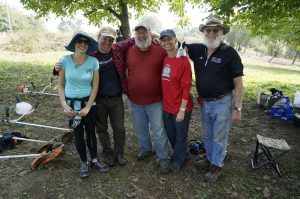
The TMF field crew still cheerful after five hard days of work: from left, Rachael, Przemek, Steven, Rachel, and Bruce. Photo © 2018 RJH.
Steven gave us the guidance and challenges that we needed to grow into this role, in addition to muscling the machines for the heaviest work. Przemek, a native of Poland who manages TMF operations in his home country, also provided friendly and practical strategy and advice to keep us running smoothly throughout the work days in Rohatyn. Bruce tended and mended the tools and the volunteers when the plants fought back, shared his curiosity and appreciation of diverse cultures, and joined Steven in running repartee that kept the entire crew in stitches. And we very much appreciate the “invisible” but essential TMF board members, Joann Siegienski and others, who helped the field crew organize and fundraise to make this project possible.
For anyone not already familiar with the important motivations of The Matzevah Foundation, the interfaith purpose to their work, their long record of Jewish cemetery projects, and how to support them now so they can continue their important work, we invite you to visit their web site for more information.
– Peace Corps Volunteers
We have had a long and excellent relationship with Peace Corps volunteers in Ukraine and in Rohatyn, which we’re sure will continue for many years to come; their spirit and practical accomplishments are admirable, and they are wonderful to talk and work with. And not just for us: their engagement with Ukrainians of all ages during their own work and while helping us at the cemetery was obvious every day, and they live the role of cultural ambassadors for America in all of these encounters.
Jonathan Pamel sought us out and joined us working at the headstone recovery project led by the Lviv Volunteer Center on vul. Barvinok in Lviv in June, where we had a chance to talk together about our own projects and the bridge-building we feel is essential to heritage work.
Jonathan is a “PCV” from upstate New York now working in Lviv, and through the Peace Corps network he knows many other volunteers working around the country (there are more than 300 in Ukraine now). He gathered another six volunteers from Utah, Oklahoma, Vermont, Montana, and elsewhere, with school and work experience in the US, Canada, South Korea, and Germany; they are now serving with the Peace Corps in the Kyiv, Khmelnytskyi, Poltava, Vinnytsia, and Lviv oblasts of Ukraine. Their motivations for joining our project were quite varied, as were the perspectives they brought to the work and discussions, and it was all wonderful. Each of us working in the cemetery, as well as the day visitors to the site, were very pleased to meet and share good times with Jonathan Pamel, Emmery Brakke, Kirstin Dyck, Ashly Emerson, John Lillegard, Blake Neilson, Karl Tyler, and Grayson Webster. We are glad we had a chance to talk with each of them during breaks and over dinners, because they were a blur while at work, in constant motion all over the cemetery.
Thanks to social media, we were also joined for two days by another current Peace Corps volunteer in Poltava, Linda Katz, who has been following our projects online and came to help. From Ivano-Frankivsk and Burshtyn, Ashleigh Graves-Roesler, Bryan Roesler, and Holly Turano came for the day on Tuesday to pitch in and better understand Rohatyn’s unique Jewish heritage, and also how it connects to other sites in the region; we will work with them again at a clearing project in the Kalush cemetery in October, now being organized by a mutual PCV friend there, Patty Deignan. And a tip of the hat as well to current and past PCVs and friends who have supported our work in Rohatyn and the region: Jeremy Borovitz, Abram Lyons, Casey Peel, and Leslie Nolan; there is really something special about the people who volunteer for the Peace Corps.
On our last day together in the cemetery, the PCVs presented us with a touching card with personal messages from all the volunteers still onsite, and with an amusing and remarkably detailed stick-figure drawing of Marla and me working; they also gave similar cards to The Matzevah Foundation team and to Vasyl, our driver. It was a bright ending to our time together, and a cheery memento of our first big clearing project.
– Our Ukrainian Friends
Our dear friend Vasyl Yuzyshyn not only shuttled the entire large crew around Rohatyn throughout each of our days, he also interpreted for us at shops and during meals, repaired and fabricated hand tools, explained the project to neighbors and visitors, answered questions at the hotels, and problem-solved for us when issues came up; his workday was always the longest of the team. And despite working hard all day on all of those tasks, he also pitched in to cut trees and stumps in the cemetery which were too large for the loppers; it’s strenuous work but his good cheer never faded. This is the second year running Vasyl has been our transport and communications lifeline during work weeks in Rohatyn, and we treasure his gentle and friendly manner when he speaks on our behalf in town.
On Monday, we were thrilled to have Iryna Nebesna join us for the day’s work; she got up at 5:30am in Ternopil to catch ground transportation to Rohatyn and then walked to the cemetery. We have worked with Iryna on other Jewish heritage projects in the region organized by the Lviv Volunteer Center, and were very happy she brought her warm smile and hardworking hands to our project.
Tuesday through Thursday, we also welcomed a young friend from Kalush, Yura Gulivatyy, who we had worked alongside in Boryslav during the Lviv Volunteer Center summer work camp in July; he participated there with his PCV friend Patty Deignan. In Rohatyn, Yura was the youngest member of our crew (he is 16 and had his mother’s permission to join us), but a strong, mature, and diligent worker, and a treat for the rest of us.
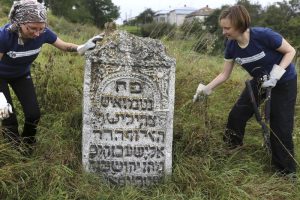
Oksana and Olena working at one of the few standing matzevot.
Photo © 2018 AP Photo / Yevheniy Kravs.
Also Tuesday thru Thursday, we were joined by Kiev-based friend Olena Kirilova, who heard about our project through Facebook and brought three of her friends: Oksana Nadyak, Oksana Martynenko, and Yehor Kachan. They were a hardworking and sensitive group, very concerned about the fate of Jewish heritage in Ukraine, and wise in their ways. Olena has also had experience volunteering with our Polish friends at Stowarzyszenie Magurycz, who restore stone grave markers at Ukrainian, Polish, and Jewish cemeteries on both sides of the border.
It was for us a privilege to work with these dedicated Ukrainian women and men who believe like us that this heritage is shared and important to all. It gives us great pleasure to know that we will see each of them again on future projects in the region, in Kalush and other planned projects, and we hope in Rohatyn again as well.
– Our Donors and Supporters
Even though each of the volunteers paid their own way to travel to Rohatyn, and our partner The Matzevah Foundation split lodging, meal, and tool expenses with us, the overall project cost was considerable, well beyond our NGO and personal capacity. We sincerely thank again the many people who answered our appeal for supplemental funds to purchase tools and supplies for this project, or who supported this project with time and materials:
The Matzevah Foundation; the Lviv Volunteer Center; Ann Appelbaum and Neal Borovitz; Kerstin Barnstorf; Ulrike und Dietrich Bauer; Guy Berfield; Heike Bernhardt; René Blättermann; Frank Böttcher; Klaus-Dieter Ehmke; Alex Feller; Dorothee Freudenberg; Jordan Friede; Mary Kalyna Hawryshkiw; Christian Herrmann; Michelle Irby; Uwe Kaminsky; Ruth Ann Kurzbauer; Susan Leibenhaut and Joseph Gootenberg; Axel Löhr; Gudrun Minnich; Marlene Möller; Cheryl Morden and Reuben Snipper; Erin Moure; Wito Nadaszkiewicz; Sasha Nazar; Eliezer Ben Pinchas; Tammy Raiton; Rhonda and Doug Robins; Lisa Rumpel; Penny Schwartz; Jutta and Eberhard Seidel; Mark Shapiro; Nancy Siegel; Ania and Witek Stępień; Rachel Stevens and Jack Wright; Izabella Tabarovsky; Karin Togler; Tom Traber; Gary Turkish; Andrea Tzadik; Ian Young; Margaret and Andrew Zalewski; and several others who donated anonymously for general program support.
During the coming week we will be cleaning, lubricating, repairing, and sharpening the tools as needed, to ready them for their next project in western Ukraine – which may be back in Rohatyn. To complete our original project concept and planning with The Matzevah Foundation, as we described in our fundraising appeals, we will then donate most of the tools and accessories to the Lviv Volunteer Center (LVC) to support their heritage preservation work in the region, we hope for years to come.
The Tools
The tools purchased for this project were medium-duty and general-purpose, to deal with the variety of mixed light to heavy vegetation in the Rohatyn old Jewish cemetery and at similar sites in the region. We purchased good-quality tools so that they can last for several years, with care in use and with regular maintenance. Tools, accessories, and supplies were needed for vegetation cutting and gathering, and for personal protection and tool service.
The cutting tools included four motorized brushcutters, each of which could be fitted with either a string head for grasses or a metal brush knife for light shrubs; these tools also require a variety of string types, fuel oil, and lubricating greases, plus fuel canisters and nozzles, replacement filters, spark plugs, etc. For heavier shrubs, saplings, and thick branches, we purchased six medium-length loppers and two tree saws. The set was completed with a small tool box and an assortment of hand tools for maintaining the cutting tools.
The vegetation-gathering tools included an assortment of seven rakes, two brooms, and a few tarps for dragging vegetation away from the cleared areas. We also brought a set of iron hooks fabricated by Vasyl for lifting headstones, but only needed them once. Of course, quite often we simply gathered and carried cut vegetation with our hands and arms.
To protect ourselves around the motor tools and from the sharp vegetation, we brought face guards, safety glasses, earmuffs for hearing protection, and an assortment of light- and heavy-duty gloves. Bruce brought a good first aid kit and protection from insects for all to use at the site, and the volunteers each brought their own protection from the weather.
Our experience on this project and on several earlier ones with TMF and the LVC will guide our choices when we need to replace or extend the tool set in the future, for use on similar projects in the region.
Clearing the Cemetery
The work crew continuously evolved through the week, with some volunteers arriving and/or departing each day to meet their own work and school needs. Beginning Tuesday afternoon, however, we had a large crew of around 20 volunteers nearly all the time, quickly gaining experience to offset the sore muscles. We were very fortunate with the weather, which at the start of the week was forecast for several rainy days, but in the end remained dry and sometimes even a bit cool.
Although the cemetery appeared at first to be primarily a sea of thick grass, the most taxing part of the week’s work was cutting the many thick shrubs and smaller trees. The motor tools were unable to penetrate two large thickets of thorn bushes or the hard shrubs growing along much of the cemetery fence line, so most of the volunteers spent significant parts of their days using the loppers to cut branches and trunks of these plants as close to the ground as possible, or dragging the cut limbs to one of several brush piles we set up around the cemetery for later disposal.
Both the cutting and the dragging are very fatiguing tasks, so each of the volunteers adapted and paced themselves to the tools and the work to keep their productivity high. We all learned rather quickly that the hand saws we used to cut the thicker shrub trunks are both very sharp and very exhausting to use, so those tools were traded off between volunteers at frequent intervals. Some of the thickest shrub trunks were left for a future clearing project, when we will return with a chainsaw and/or special attachments to the motorized brushcutters to do this specialized work.
Early Tuesday morning we assessed the largest thicket of thorn bushes in the cemetery, which was so dense we could not see more than a few meters in, and we guessed we would be unable to completely clear it during the week. However, we learned that the day was a religious holiday in the Ukrainian Greek Catholic church, the majority faith in Rohatyn, and we were asked to avoid using the motor tools that day, so the entire crew set to work on the thicket with the hand tools and together we nearly cleared it that day.
The next day began with a funeral service at the home of one of the cemetery’s neighbors, so out of respect and because the service included many prayers and songs in the yard in front of the home, we again refrained from using the motor tools until the walking funeral procession to the cemetery had departed; during that time the large thicket was completed and another was nearly cleared.
Otherwise we kept most of the motor tools running through most of each day, while the loppers and saws were used to clear the many standalone shrubs and clusters of small trees all over the cemetery field and along the fence. Typically we outfitted the brushcutters with two metal blades and two string heads to efficiently tackle both mixed light brush and heavy grass. Those of us who were less experienced with the motor tools quickly learned that the machines’ user manuals gave guidance only for simple types of vegetation, so we had to experiment to learn effective ways to safely deal with the complex mixture of plants and obstructions in the cemetery. Except for some light trimming, we intentionally left the large- and medium-sized trees, and the planted hedge growing along the fence in one corner.
We are very pleased that over the course of the five days’ work, by our estimate the crew was able to clear roughly 80% of the cemetery, much more than we had hoped – especially when we started on Monday and could see up close how difficult the work would be. We credit this success to the energy and initiative of all of the volunteers, and to the guidance, monitoring, and strategies of The Matzevah Foundation. It is quite thrilling to see the many groups of collected headstone fragments again, freed of overwhelming grass, and to be able to clearly see from one end of the cemetery to the other, well over 100m (100 yards) away.
Although everyone was careful in their efforts, some accidents and injuries to both people and tools were unavoidable. Beyond the sore muscles from working the tools and dragging the cut vegetation, several in the group suffered blisters and over-twisted joints, and nearly everyone had at least some cuts and scrapes – the thorn bushes especially resisted their fate. The uneven ground surface and the masking vegetation led one volunteer to step on an unseen obstacle and re-injure a toe he had broken a month earlier; typical of the determination of the volunteers, after a quick trip to the doctor he returned to the cemetery and joined in the work again, waving off suggestions that he rest. Blades on a few of the tools were damaged when “vines” the crew attempted to cut turned out to be metal debris, but Bruce was able to grind those blades back into form; we will check all the tools for loose joints and damage before their next use.
Our group was entertained throughout the week by a large number of chickens grazing in the cemetery during the day, associated with two huge, flamboyant roosters. The chickens were surprisingly unafraid of us and our tools, running away only when vegetation was flying. We quickly learned that we were stirring things up for them, helping them to find insects to eat; as the days progressed we found them waiting for us each morning to arrive and whip up breakfast for them.
Clearing Around the South Mass Grave Memorial
Since the intensive clearing done by the City of Rohatyn over the south mass grave site last year ahead of the non-invasive archaeological survey there, particularly high and dense vegetation grew on the very fertile soil, nearly hiding the memorial monument at the site.
As a side project while the funeral was in progress near the cemetery on Wednesday, two of us took brushcutters to the south mass grave site and in about an hour cleared an area around the monument so that visitors can see and access it; we left the trees and larger rose bushes which have decorated the site for years. Until we are able to prepare and install new ground cover marking the boundaries of the mass grave in the next year or two, we will plan to spend a day perhaps in spring and in fall to clear the rapidly-growing plants and grasses.
Visitors and City Tours
The noise and activity of course attracted some attention to our work in the cemetery, prompting a few of the cemetery’s neighbors to visit and ask about our project. We were especially pleased by the arrival of Mykhailo Vorobets to the cemetery, to greet and welcome the volunteers to his town. Because many of the volunteers speak Ukrainian, Mr. Vorobets was able to speak freely about his life in Rohatyn and about his recollections of the Holocaust in town which he witnessed as a boy. Mr. Vorobets explained that he is 84 years old now and not so able to care for Jewish heritage sites as he has done for decades; we know that he has not been well for much of this year, and unable to attend some events in town; we wish him better health in the future. It was a real treat to see his broad smile facing the attentive faces of the volunteers surrounding him in the cemetery.
Also on Wednesday we were joined by a photographer and videographer working for the Associated Press (AP) in Ukraine, sent by AP staff writer Vanessa Gera, a Warsaw-based journalist we had met a few weeks earlier. The AP team filmed the activity at the cemetery and the south mass graves, conducted interviews with Steven and Marla and others, including Mr. Vorobets. We are looking forward to their coverage of our international project and the volunteers who powered it. [Update: A nice AP news article with photos focusing on The Matzevah Foundation’s charitable work was published on the AP website two weeks after the project ended, and was picked up by other news agencies for their own publications. The same day, AP Archive published video material suitable for use by TV news organizations as a seven-minute segment with a text storyline, both on the AP website and on their YouTube channel. We are grateful for the coverage!]
The project was not all work, of course. On the Sunday before the work week, Marla and I welcomed our friends of The Matzevah Foundation to Rohatyn and gave them a tour of the town’s central square and the Jewish and Ukrainian historical sites, including the former old Jewish residential and synagogue district, and the 17th-century Holy Spirit wooden church (a UNESCO-recognized national cultural treasure); Bruce and Steven had seen these sights last year, but it was the first visit to Ukraine for Rachel, Rachael, and Przemek. On Tuesday morning, Marla led a similar tour for the rest of our volunteer crew of Peace Corps and Ukrainian friends, most of whom had not previously visited Rohatyn. It is always a treat for us to share what we have learned about Rohatyn with interested visitors.
The Work Left To Do
The grass cut and shredded by the brushcutters was already drying while we worked, and will decay to become nutrients for the remaining plants in the old cemetery. However, there was much more heavy brush and thick-stemmed shrubbery in the cemetery than we realized during project planning this past year; that extra challenge was sized up quite quickly by Steven and Przemek when we first walked the site the day before work began last week. Lots of heavy brush meant lots of manual hauling of the cuttings, and several large piles of stacked branches left behind in the cemetery when we departed. Based on their past experience in Poland, TMF advised us to stack the waste greenery away from trees and overhead power lines. Before we left, Vasyl helped us make arrangements with a man we have met before who lives adjacent to the cemetery to carefully burn the cut vegetation after it has partly dried; this is a long-standing practice in rural areas of western Ukraine (and in Poland), and we will follow up to see how that work progresses at the site.
Now Marla and I will take stock of the remaining weeks of good weather and the clearing work which remains at the old and new Jewish cemeteries in Rohatyn, to decide what we might be able to accomplish this year and what should be put off until next year. Part of the future work at the old cemetery will involve new tool purchases for specialized equipment such as saw attachments for the brushcutters and/or a smaller chainsaw for trimming the stumps of the heavy shrubs close to the ground.
In addition to the physical work ahead, we have also been collecting notes from this large project as well as prior volunteer projects we joined in Poland with The Matzevah Foundation and Stowarzyszenie Magurycz, to begin sharing what we have learned with leaders of other, similar projects in the region. Much of the knowledge which is needed by us and others can really only be gained by direct experience, so we are grateful that others have been so kind in sharing their years of practice with us as we slowly learn the basics.
A Final Note
This project gathered an international crew of nearly two dozen volunteers to work together for most of five days to achieve something remarkable, even astonishing for those of us who have been visiting the old Jewish cemetery of Rohatyn repeatedly over the past several years. Beyond the working crew at the site, many more people at a distance provided assistance, funding, and encouragement without being able to see the site first-hand and walk among the recovered matzevot to admire their carved epitaphs and symbols. We hope that the photos on this page will give a feel for the experience as we lived it, to all the people who expressed interest in the project and supported us from afar, including other volunteers for The Matzevah Foundation, other Peace Corps volunteers in Ukraine and beyond, many other Ukrainian friends, and the large number of Jewish descendants who share our connection to Rohatyn.
Rachel McRae of TMF filmed a three-minute video on our last morning at the cemetery, with Steven Reece and Marla discussing the project in a Q&A format, with recovered headstones visible in the background while brushcutters whined in the distance. It’s easy to see Marla’s joy at the great progress made for all of us by friends both near and far (video © 2018 TMF):

